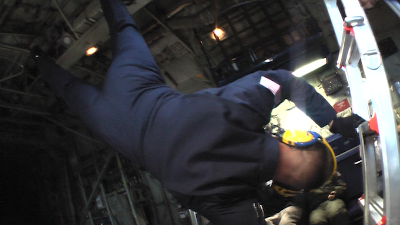
This is a regular blog post. If you’re looking for show notes to a video or audio episode, you’ve come to the right place. Just keep scrolling. It’s all here!

I sat further aft than last time and I’m glad I did. The guys in the back do this all the time and are pretty good at knowing the flight profile and when they’re going to be at zero-G. And taking advantage of it. The shot above is not photoshopped. It’s the real deal. I got it from my seat with the hand-held. He has a good grip on the ladder and the ladder is firmly secured to the cargo deck. But it’s still pretty dramatic-looking.
The main camera for the rear compartment was up on the front bulkhead looking back. It’s rock-solid and doesn’t vibrate. I’ll pull some frame grabs from that one and post them soon.











